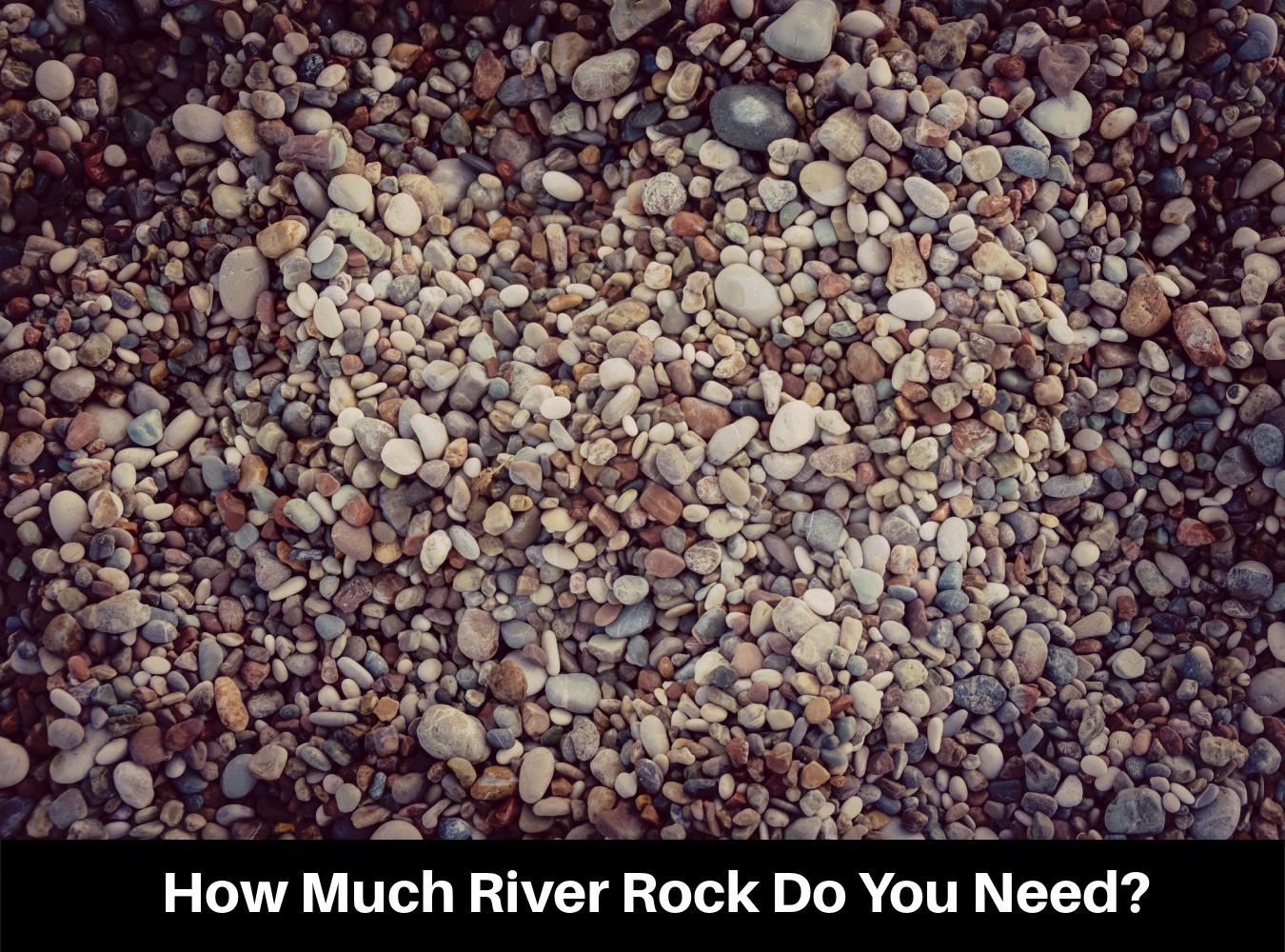Enter your landscape project’s length, width, and desired river rock depth to calculate the weight and volume of rock you’ll need. You can choose from one of twenty types of popular landscape rock and gravel. The calculator also works whether you’re measuring in feet, inches, yards, centimeters, meters, or kilometers.
What Are River Rocks?
River rocks naturally occur in rivers and streams. These small round rocks are ideal for replacing mulch, lining walking paths, and as landscape decoration. River rocks come in many shades, but the standard variety is a mixture of gray, beige, and brown.
The density of standard river rock is 1425kg/m³, which is an important figure when determining how much river rock you need for your project.

Types of Landscape Rocks
There are multiple types of river rock that range from small, pebble-like pea gravel to extra large 8″ stones. Since all landscape rocks have different densities, the amount needed to fill a space varies by type.
| Rock Type | Description | Density (kg/m³) |
|---|---|---|
| Standard River Rock | Smooth, round rocks. Primarily brown, beige, and gray. | 1425 |
| Bank Gravel | Unprocessed gravel from river beds — a mixture of rocks, dirt, and sand. | 1483 |
| Cheshire Pink Gravel | Decorative stone with natural pink and brown hues. | 1545 |
| Congo River Rock | A natural river rock. | 1314 |
| Cotswold Buff Gravel | Gravel with a cream color and a chipped, angular shape. | 1670 |
| Cotswold Gold Gravel | A gold-colored gravel made from limestone chippings. | 2098 |
| Crushed Asphalt | Recycled asphalt pavement, crushed into small gravel like pieces. | 721 |
| Crushed Granite Stone | Granite that manufacturers crush into pieces to make small stones. Comes in an assortment of colors. | 1320 |
| Crushed Stone | Crushed stone comes from a large rock that gets pulverized to make smaller pieces. | 1602 |
| Crystal River Rock | A type of river rock that may feature some or all crystalized or translucent pieces. | 1522 |
| Dolomite Gravel | Crushed white rock, popular for landscaping. | 1865 |
| Granite | A natural rock that comes in many sizes. | 2650 |
| Ivory Coast Gravel | Small gravel, sometimes used for fish tanks. | 1506 |
| Pea Gravel | A small type of river rock popular for landscaping. | 1788 |
| Peace River Rock | A tiny black rock. | 1490 |
| Quartzite | A natural metamorphic rock that comes in a range of colors. | 2700 |
| Regular Gravel | Loose, round pieces of stone, often gray or gray and brown. | 1346 |
| Sunset Gold Gravel | A dark gold landscaping rock. | 1505 |
| White Marble Chips | A white decorative landscape rock. | 1430 |
How to Calculate How Much River Rock You Need in Cubic Meters, Kilograms, and Tons
To determine how much river rock you need, figure out the volume of the space you’ll be filling in cubic meters.
Volume = length x width x depth
To do this, measure the area’s length, width, and depth in meters. For example, if you need to fill a flower bed that measures 3 meters long and 1 meter wide and you want your river rock to be 8 centimeters deep, you’ll multiply 3 x 1 x 0.08 for a volume of 0.24 m³.
Once you know the volume of your landscaping project, multiply the volume by the density of the rock to determine the weight in kilograms.
Weight = volume x density
In our example, we’ll fill our flower bed with standard river rock with a 1425 kg/m³ density.
- W= 0.24 x 1,425
- W = 342 kg of standard river rock
You can calculate kilograms to tons by dividing by 907.185
- Tons = KG/907.185
- Tons = 342/907.185
- 0.3769 tons = 342 kg
How to Measure How Much River Rock You Need in Cubic Yards and Cubic Feet
Most rock and gravel are sold by the ton, making our calculator and the above equation ideal for determining river rock needs. In the United States, though, smaller amounts of rock are sold by the cubic yard or cubic foot.
Determining the cubic yards of an area is easy. You’ll need length, width, and depth measurements in feet for these calculations.
Cubic Yards = Length (ft) x Width (ft) x Depth (ft) / 27
Here’s an example: We want to fill a garden bed with river rock. Our bed measures 10 feet long and 3 feet wide. We want our river rock to be 3 inches deep, which is equal to .25 feet.
- Cubic Yards = 10 x 3 x .25 / 27
- Cubic Yards = 0.277
We now know we need to purchase enough bags of river rock to equal at least 0.277 cubic yards.
To determine cubic feet, multiply length x width x depth in feet.
Cubic Feet = Length (ft) x Width (ft) x Depth (ft)
In our above example, we’d multiply 10 x 3 x .25 for 7.5 cubic feet.
Do You Need to Account for Waste When Purchasing River Rock?
Buying extra rock to account for waste is a good idea. An ideal wastage factor for river rock is 5%. You can multiply the cubic yards or tons of rock by 1.05 to get a total number.
For example, if we need 0.277 cubic yards of river stone and want to add 5%, we’ll multiply 0.277 by 1.05 for a total of 0.291 cubic yards.


